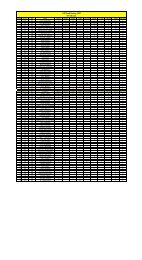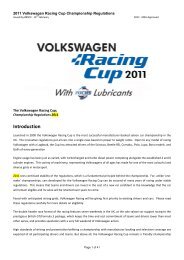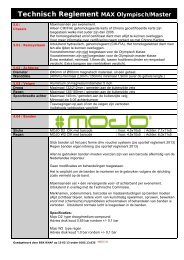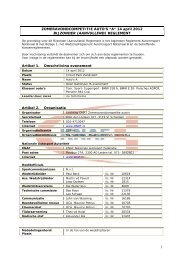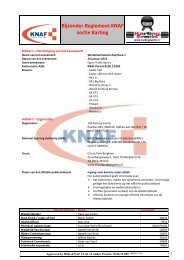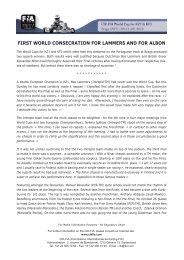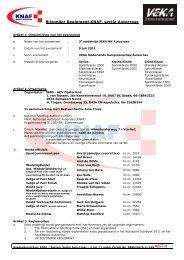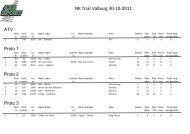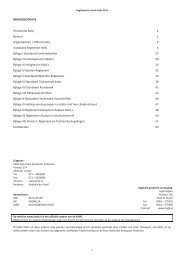general / sporting and technical regulations 2012 - Knaf
general / sporting and technical regulations 2012 - Knaf
general / sporting and technical regulations 2012 - Knaf
Create successful ePaper yourself
Turn your PDF publications into a flip-book with our unique Google optimized e-Paper software.
GENERAL / SPORTING AND TECHNICAL REGULATIONS<br />
<strong>2012</strong><br />
A. GENERAL / SPORTING REGULATIONS<br />
1. INTRODUCTION<br />
The aim of the “Supercar Challenge powered by Dunlop” (SC) is to organise events<br />
on FIA approved racetracks in Europe with as broad a range of car br<strong>and</strong>s <strong>and</strong><br />
models as possible, based on simple <strong>technical</strong> <strong>regulations</strong>.<br />
It is hoped-for that a certain mutually competitive equality will be achieved by splitting<br />
cars into five divisions, see Article 7, based on the ratio between a car’s weight <strong>and</strong><br />
engine power, combined with a result-dependent h<strong>and</strong>icap rule.<br />
Drivers can participate in a wide variety of racecars like GT’s <strong>and</strong> Touring Cars,<br />
based on road going cars or purpose build. Before a car is accepted the participant<br />
has to submit his car to VRM for approval. The SC is not open for Formula Cars.<br />
Used terms:<br />
FIA<br />
KNAF<br />
TC<br />
ASJ<br />
ASN<br />
SC<br />
VRM<br />
Fédération Internationale de l'Automobile<br />
Knac Nationale Autosport Federatie (ASN)<br />
Technical Commission<br />
KNAF Autosport Yearbook<br />
Only FIA approved organising body in country<br />
Supercar Challenge powered by Dunlop<br />
V-Max Racing Management B.V. in Breda<br />
2. ORGANISATION<br />
The Supercar Challenge powered by Dunlop is an by the KNAF (ASN) approved<br />
Challenge.The SC is run under the Benelux Zone Regulations <strong>2012</strong> organised <strong>and</strong><br />
promoted by V-Max Racing Management B.V. (VRM), Schapendreef 78, 4824 AM<br />
Breda, the Netherl<strong>and</strong>s<br />
3. REGISTRATION<br />
Registration takes place using a registration form provided by VRM. The registration<br />
form must be filled in completely <strong>and</strong> signed under penalty of non-acceptance. By<br />
registering, a participant accepts all the <strong>regulations</strong> as well as the instructions issued<br />
by the competition organiser. An official Organiser’s entry form must be filled in <strong>and</strong><br />
signed by each competitor for each event to be entered.<br />
approved <strong>2012</strong> SC Regs 19-04-<strong>2012</strong>
In each event, VRM can admit so-called “guest drivers” or “guest cars” after payment<br />
of the registration fee. A guest driver is a participant taking part in less than eight<br />
races (four events).<br />
Registration fees remain the property of VRM even if a car or driver(s) does not<br />
compete. No reimbursement will be made, neither wholly nor in part, for registered<br />
cars or drivers excluded by the event organisers. The registration fee will only be<br />
returned in full when registration is refused. A guest car or guest driver is entitled to<br />
as many tickets as those issued to a registered car or driver, as stated in Article 3.<br />
These guest cars or guest drivers must likewise comply with the General, Sporting<br />
<strong>and</strong> Technical Regulations. If necessary, VRM can allocate extra ballast weight or<br />
h<strong>and</strong>icap seconds. Furthermore, these guest cars or guest drivers must fully<br />
complete the registration <strong>and</strong> information form <strong>and</strong> send it to VRM before the closing<br />
date for the meeting in question.<br />
The level of the registration fees for participation in an individual event will be<br />
determined per event <strong>and</strong> will be indicated on the registration form.<br />
Every registered car (number) is entitled to the following in each event:<br />
2<br />
4<br />
4<br />
1<br />
1<br />
2<br />
4<br />
<br />
guardrail tickets;<br />
pit lane passes<br />
paddock passes<br />
entry pass paddock TRUCK;<br />
entry pass paddock car, depending on circuit facilities.<br />
VIP passes Hospitality awning<br />
VIP passes against reduced cost ( € 35,= ex VAT)<br />
Other VIP arrangements can be booked for € t.b.a.<br />
Book at least 2 weeks in advance for each event.<br />
All additional information about the Supercar Challenge will be sent to the<br />
correspondence or e-mail address given on the registration form.<br />
Any invoices from the VRM must be settled before administrative checking.<br />
4. ADMINISTRATIVE CHECK<br />
Place <strong>and</strong> time of the administrative check will be indicated on the invitation for the<br />
event concerned.<br />
During the administrative check every driver must report in person.<br />
The following will be checked:<br />
Driver's / Entrant / Team Licence<br />
Registration form<br />
Payment of the registration fee.<br />
Whether the registration form <strong>and</strong> the indemnity clause have been signed.<br />
This must be done by all drivers of a team per registered car.<br />
<strong>2012</strong> SC Regs. V8 19-04-<strong>2012</strong> 2
5. WAIVER OF LIABILITY<br />
The entrants shall participate in the test sessions <strong>and</strong> meetings aware of the special<br />
risks involved in motor racing <strong>and</strong> at their own risk. They shall assume full civil <strong>and</strong><br />
criminal responsibility for any damage they or the vehicles used by them cause,<br />
unless an exemption from liability was agreed.<br />
When entering, competitors <strong>and</strong> drivers waive their right to claim any damages in<br />
connection with the event <strong>and</strong>/or the official test sessions/introductory course<br />
against:<br />
– the FIA, the KNAF, other ASN's <strong>and</strong>/or its affiliated organizations, their<br />
presidents, executive bodies, managing directors, secretaries <strong>general</strong>,<br />
volunteers <strong>and</strong> employees;<br />
– the promoter/series organizer V-Max Racing Management b.v. <strong>and</strong> the series<br />
sponsors;<br />
– the event host, officials <strong>and</strong> assistants, race-track owners, government<br />
agencies, racing services, manufacturers <strong>and</strong> all other persons <strong>and</strong> entities<br />
involved in organizing a meeting;<br />
– the organization responsible for the construction <strong>and</strong> maintenance of roads,<br />
where damage is caused by the condition of the roads (including road<br />
furnishings) used during the competition; <strong>and</strong><br />
– any agents or other persons employed to perform an obligation on behalf<br />
of the above persons <strong>and</strong> entities.<br />
Except for damage or harm to life, body or health resulting from the intentional or<br />
negligent breach of duty by the group of persons exempted from liability, their legal<br />
representatives or agents <strong>and</strong> except for any other damage resulting from the<br />
intentional or grossly negligent breach of duty by the group of persons exempted<br />
from liability, their legal representatives or agents. They also waive any claims for<br />
damages in connection with the racing competition (timed <strong>and</strong> untimed practices,<br />
warm-ups, races) <strong>and</strong>/or the official test sessions/introductory course, except for<br />
damage or harm to life, body or health resulting from the intentional or negligent<br />
breach of duty by the group of persons exempted from liability, their legal<br />
representatives or agents <strong>and</strong> except for any other damage resulting from the<br />
intentional or grossly negligent breach of duty by the group of persons exempted<br />
from liability, their legal representatives or agents against:<br />
– the other competitors (entrants, drivers, co-drivers), their assistants, the owners<br />
or registered keepers of other vehicles;<br />
– the competitor on whose behalf they entered, their own driver(s)/co-driver(s)<br />
(barring any other special agreements between vehicle owners or keepers,<br />
competitors <strong>and</strong> driver/s <strong>and</strong>/or co-driver/s) <strong>and</strong> their own assistants.<br />
The exclusion from liability shall become effective for all parties concerned upon<br />
submission of the entry form.<br />
The waiver of liability shall apply to claims for any legal reason whatsoever, including<br />
but not limited to claims for damages based on contractual <strong>and</strong> non-contractual<br />
liability <strong>and</strong> to claims from tortuous liability. Implied exclusions from liability shall<br />
remain unaffected by the above non-liability clause. By submitting an entry, the<br />
entrant/competitor/driver acknowledges that damage or injuries sustained during a<br />
meeting are not covered under m<strong>and</strong>atory motor insurance (vehicle third party<br />
liability, collision & comprehensive or fire <strong>and</strong> theft). Should any injury occur or be<br />
<strong>2012</strong> SC Regs. V8 19-04-<strong>2012</strong> 3
discovered during a meeting or in the event of health impairments which may<br />
temporarily or permanently jeopardize the ability to drive a racing car, considering the<br />
safety risks this may pose to third parties, with their signature the entrants shall<br />
release all attending physicians from confidentiality with respect to the officials (the<br />
Medical Officer, the Race Director/Clerk of the Course, the Stewards of the Meeting).<br />
The entrants underst<strong>and</strong> that the FIA licence provides accidental injury protection to<br />
the driver. They shall underst<strong>and</strong> that in the event of claims for damages among the<br />
amount. The exact scope <strong>and</strong> maximum cover amounts of the organisers’ or<br />
participants’ third party liability insurance shall be available upon request from the<br />
organiser competitors, drivers, vehicle owners or keepers, the organisers’ or<br />
participants’ third party liability insurance usually covers only bodily injury (not any<br />
material damage) resulting from gross negligence. They shall furthermore take note<br />
of the maximum cover<br />
.<br />
5.1 Vehicle owner’s waiver of liability<br />
(1) Entrants/drivers who do not own the race vehicle they use shall obtain the vehicle<br />
owner’s signature on the waiver printed on the entry form.<br />
(2) Should the vehicle owner fail to meet his/her obligation to sign the waiver, the<br />
entrants or drivers shall hold all persons <strong>and</strong> institutions mentioned under Art. 5 free<br />
against any vehicle owners’ claims, except for damage or harm to life, body <strong>and</strong><br />
health resulting from the intentional or negligent breach of duty by the group of<br />
persons exempted from liability or their legal representatives <strong>and</strong> agents <strong>and</strong> any<br />
other damage resulting from the intentional or grossly negligent breach of duty by the<br />
group of persons exempted from liability, their legal representatives or agents. (3) In<br />
the event of claims against the other competitors (entrants, drivers, co-drivers), their<br />
assistants, the owners or registered keepers of other vehicles, the competitor on<br />
whose behalf they entered, their driver/s <strong>and</strong>/or co-driver/s (special agreements<br />
between the competitors <strong>and</strong> driver/s <strong>and</strong>/or co-driver/s shall prevail) <strong>and</strong> their own<br />
assistants, this waiver applies to damage or injuries in connection with racing (timed<br />
<strong>and</strong> un-timed practices, warm-ups, races). In the event of claims against other<br />
persons or institutions this waiver applies to damage or injuries in connection with the<br />
entire <strong>sporting</strong> event. Implied exclusions from liability shall remain unaffected by the<br />
above.<br />
5.2 Responsibility, amendments to the Rules <strong>and</strong> Regulations, cancellation of a<br />
meeting<br />
Competitors, drivers, co-drivers, vehicle owners <strong>and</strong> keepers shall participate in the<br />
competition aware of the special risks involved in motor racing <strong>and</strong> at their own risk.<br />
They shall assume full civil <strong>and</strong> criminal responsibility for any damage they or the<br />
vehicles used by them cause, unless an exclusion of liability was agreed.<br />
VRM reserves the right to make any necessary amendments to the present Rules<br />
<strong>and</strong> Regulations in coordination with KNAF after their approval.<br />
The organiser reserves the right to modify the Supplementary Regulations, after<br />
approval by the panel of stewards, as required by force majeure, security concerns or<br />
the authorities <strong>and</strong> to cancel the series or individual races if required in extraordinary<br />
circumstances. The organiser shall not assume any liability except for intentional or<br />
gross negligent acts. Other than the above, the organiser shall be liable unless the<br />
Rules <strong>and</strong> Regulations <strong>and</strong> entry form provide an exclusion of liability.<br />
<strong>2012</strong> SC Regs. V8 19-04-<strong>2012</strong> 4
Supercar Challenge races will be held under the responsibility of the local event<br />
organiser, during events endorsed by the local ASN <strong>and</strong> listed on the National <strong>and</strong><br />
Benelux Zone Calendar.<br />
6. PREVAILING REGULATIONS<br />
The Supercar Challenge is a Dutch ASN (KNAF) approved series within the<br />
framework of the FIA International Sporting Code <strong>and</strong> is organised under the Benelux<br />
Zone Regulations <strong>2012</strong>.<br />
The following applies:<br />
- The FIA International Sporting Code <strong>2012</strong> <strong>and</strong> it’s Appendices.<br />
- The local ASN <strong>regulations</strong> applicable for the event concerned.<br />
- These Supercar Challenge <strong>2012</strong> <strong>regulations</strong>.<br />
- The Supplementary Regulations.<br />
- The specific <strong>regulations</strong> of the circuit where the event is held.<br />
7. CLASSIFICATION<br />
7.1 The five divisions in the Supercar Challenge<br />
There are five DIVISIONS:<br />
1. Super GT<br />
2. GT<br />
3. Supersport<br />
4. Sport 1<br />
5. Sport 2<br />
Because of the wide variety of cars, an objective classification has been chosen<br />
based on a “weight/power” ratio. In this way, our aim is to equalise cars participating<br />
in a class as fairly as possible.<br />
The aim is that the driver or guest driver, <strong>and</strong> not the type of car, has the most<br />
influence on the results. For this reason, VRM has the right to deviate from this<br />
classification based on the ratio between power <strong>and</strong> weight, <strong>and</strong> to allocate extra or<br />
less ballast weight.<br />
If someone registered, i.e. a driver <strong>and</strong>/or guest driver, has an unreasonable<br />
advantage or disadvantage compared to other participants in the class as a result of<br />
the type of engine or special road-holding qualities, VRM can decide to impose a<br />
higher or lower minimum weight, or place him or her in a higher class. Only to be<br />
applied before the start of the concerned event.<br />
<strong>2012</strong> SC Regs. V8 19-04-<strong>2012</strong> 5
7.2 Class divisions.<br />
Sport 2<br />
: For cars up to 2.500cc max. 6 cylinders<br />
more than 5.5 Kg/HP, no minimum weight.<br />
Plus minimum laptime requirements per track visited.<br />
Sport 1<br />
Supersport<br />
GT<br />
SuperGT<br />
: For cars up to 3200 cc max. 6 cylinders<br />
More than 5,2 Kg/HP, no minimum weight.<br />
: between 4.5 <strong>and</strong> 5.2 Kg/HP.<br />
: between 3.7 <strong>and</strong> 4.5 Kg/HP.<br />
: between 2.8 <strong>and</strong> 3.7 Kg/HP.<br />
1. Calculation power to weight ratio: weight (car + driver) divided by HP measured<br />
at the wheels.<br />
2. Capacity calculation factor for turbo <strong>and</strong> supercharged engines: 1.7<br />
3. For cars in the Division Sport 2 additional “performance balance” measures may<br />
be enforced by VRM if lap times are not within limits. Limits will be published<br />
per track.<br />
4. VRM has the right to grant waivers for the above stated rules if a car cannot<br />
comply with this rules because of weight or engine capacity as long as this<br />
gives no unrealistic advantage against the other competitors.<br />
The weight is based on a ready to drive race car with driver (with full driver’s<br />
equipment), inclusive 1 litre of fuel. This can be checked during the <strong>technical</strong><br />
scrutineering after the qualifying session <strong>and</strong> after the race.<br />
All cars, competing in Supercar Challenge should at least comply to Appendix J,<br />
article 277, except for the fire extinguisher. See art. 4 of the safety <strong>regulations</strong>.<br />
“Zilhouette” cars will be accepted, based on the Dutch Zilhouette Cup.<br />
7.3 Compulsory determination of engine power.<br />
The engine power will be “live” measured on the event venue with a Powerlog © to be<br />
supplied by VRM against a deposit of € 475,00. This unit measures during the<br />
qualification <strong>and</strong> races the applied power at the wheels.<br />
If there is reason to doubt the correctness of placement in a particular class based on<br />
the results achieved <strong>and</strong> the lap times in particular, VRM can check the stated power<br />
<strong>and</strong> minimum weight of any car after the end of a qualifying session or race by<br />
downloading the data from the Powerlog © . The driver/guest driver/owner of the car<br />
must cooperate with the powercheck without any reservation.<br />
<strong>2012</strong> SC Regs. V8 19-04-<strong>2012</strong> 6
If the power <strong>and</strong> weight combination does not tally with the set power/weight ratio for<br />
this division the car is in breach of the <strong>regulations</strong>, this will be dully reported to the<br />
Clerk of the Course <strong>and</strong>/or Stewards of the Meeting. If the competitor concerned is in<br />
non conformity more than once this may lead to non participation for the rest of the<br />
season by non invitation of the concerned driver for future events.<br />
The data received via the Powerlog © is the only data used to check compliance with<br />
the <strong>regulations</strong>. Data supplied by the drivers from rolling roads or dyno’s is not<br />
accepted.<br />
7.4 Exemption<br />
An exemption for one-off guest drivers from this means of power measurement will<br />
be determined by VRM before the start of the said event.<br />
7.5 H<strong>and</strong>icap seconds<br />
After the end of a race, drivers placed in the first three positions according to the<br />
provisional result, are allotted h<strong>and</strong>icap seconds according to the table shown below.<br />
These seconds are in addition to those allotted after the previous race. These<br />
seconds will be added to the 60 seconds for the compulsory pit stop <strong>and</strong> with any<br />
previously allotted extra h<strong>and</strong>icap seconds <strong>and</strong> apply to the next race.<br />
1 st place in a race = plus 15 seconds<br />
2 nd place in a race = plus 10 seconds<br />
3 rd place in a race = plus 5 seconds<br />
Any changes in the result through protests or penalties, will have no effect on this<br />
allocation.<br />
The h<strong>and</strong>icap seconds are linked to the driver or guest driver. These seconds are<br />
maintained even if the driver changes car (type) within the same class during the<br />
season.<br />
If a driver misses an event VRM has the right to add seconds to the already achieved<br />
result seconds depending on the current situation.<br />
Guest drivers: VRM determines the allocation of any h<strong>and</strong>icap seconds for guest<br />
drivers.<br />
Two drivers sharing one car: If two drivers have different h<strong>and</strong>icap seconds the<br />
highest h<strong>and</strong>icap applies.<br />
<strong>2012</strong> SC Regs. V8 19-04-<strong>2012</strong> 7
7.6 Reduction<br />
The result achieved during the next race/event applies as calculation.<br />
If the result achieved is 4 th place or lower, the number of penalty seconds can be<br />
reduced according to the table below.<br />
4 th place in a race = minus 5 seconds<br />
5 th place in a race = minus 10 seconds<br />
6 th place or lower in a race = minus 15 seconds<br />
Participation takes place when the driver or guest driver in a race passes the starting<br />
line after the starting signal or leaves the pit exit. In case a car is damaged <strong>and</strong> not<br />
able to start for the second race during the same event this also will be h<strong>and</strong>led as<br />
started <strong>and</strong> a maximum of 15 seconds will be reduced from the h<strong>and</strong>icap seconds.<br />
7.7 Scales<br />
To establish the minimum car weight, an indicated tolerance of 2 kg applies to the<br />
scales used by the organisation of the SC <strong>and</strong> are the only official scales for the SC.<br />
7.8 Timing transponders<br />
Competitors shall fit their vehicles with an AMB/Mylaps timing transponders at their<br />
own cost to enable exact timing. Such devices shall be installed in the approved<br />
location(s) <strong>and</strong> manner as communicated in the manufacturers datasheet.<br />
7.9 Tyre <strong>regulations</strong><br />
VRM has signed a sponsorship contract with tyre manufacturer Dunlop. All<br />
participants are therefore compelled to use Dunlop br<strong>and</strong> tyres to be supplied via<br />
MUSKO Racing. Participants are entirely free though to choose the type of tyre,<br />
compound <strong>and</strong> size.<br />
The number of slicks for the qualifying session <strong>and</strong> both races shall be limited. No<br />
restrictions shall apply to rain tyres, but their use shall be subject to the Race<br />
Director/Clerk of the Course declaring a “wet practice” or “wet race”. Each<br />
competition vehicle can be supplied with an maximum of ten (10) slicks to be<br />
marked by Musko Racing for use by this specific vehicle before the start of the<br />
event. Untimed practices may be run using unmarked slicks <strong>and</strong> also the marked<br />
slicks from the previous meetings. Exceptions may be granted by the series<br />
Permanent Scrutineers. If a tyre is punctured or severely damaged on a racing<br />
weekend, a “joker tyre” may be requested from Musko Racing . Such tyre must be<br />
authorised by the Permanent Scrutineers <strong>and</strong> marked as “joker tyre” if applicable. No<br />
more than 3 joker tyres shall be allowed for the first four races of the season, <strong>and</strong><br />
three additional joker tyres for the last five races.<br />
During all races, Musko Racing from Oud Gastel will be present to supply tyres<br />
directly. It is recommended that you reserve the tyres you require beforeh<strong>and</strong>.<br />
Musko Racing, Zaagmolen 4, 4751 VL Oud Gastel, NL<br />
0031620139069 Mr. Kees Konings kees@muskoracing.nl<br />
<strong>2012</strong> SC Regs. V8 19-04-<strong>2012</strong> 8
7.10 Exemption<br />
Exemption can only be granted if Dunlop is unable to supply suitable tyres (to be<br />
judged by VRM). If exemption is granted the cost per event amounts to € 250,00<br />
excluding VAT.<br />
8. PRIZE GIVING<br />
After each race/event there will be a podium ceremony for the first three cars/drivers<br />
per division.<br />
8.1 Scoring <strong>and</strong> overall st<strong>and</strong>ings per class<br />
In each race, regardless of its length, points will be awarded to participants using the<br />
distribution below.<br />
Position: 1 st 2 nd 3 rd 4 th 5 th 6 th 7 th 8 th 9 th 10 th<br />
Number of points: 20 18 16 14 12 10 8 6 4 2<br />
The driver with the highest number of points in the relevant class is Supercar<br />
Challenge Winner SuperGT, GT, Supersport or Sport divisions. The driver with the<br />
highest number of points in the challenge is overall Winner.<br />
All results shall count towards the year-end st<strong>and</strong>ings. There are no scratch results.<br />
For each race, an overall race result <strong>and</strong> a ranking per class will be drawn up. If two<br />
drivers are participating in the same car, both receive points corresponding to the<br />
result achieved. Points for pole position (one point) <strong>and</strong> the fastest lap in the race<br />
(one point) per division will be likewise awarded to both drivers. If there is a double<br />
race during a weekend, the point for the pole position for the second race will be<br />
awarded on the basis of the result of the first race.<br />
Starters shall be eligible to earn points after covering at least 75% of the winner’s<br />
(per division) distance.<br />
Points shall be awarded only if at least 5 competitors per division start into a race.<br />
Participants who join less than 4 events ( 8 races) will be treated as guest drivers <strong>and</strong><br />
will not be included in the scoring <strong>and</strong> will not receive any points.<br />
If desired, a team can be registered which is eligible for points. A team may consist of<br />
three participants at most. It is a condition that each of these participants drive at<br />
least four races for the team.<br />
9. PARTICIPANTS / PARTICIPATION<br />
9.1 Participation<br />
The Supercar Challenge is open to participants with a National license with EU<br />
endorsement or an International licence issued by an ASN. Competitors <strong>and</strong> drivers<br />
from outside the EU <strong>and</strong> comparable countries by decision of the FIA need (a)<br />
special authorization(s) <strong>and</strong>/or approval of their own ASN (FIA ISC Art. 47 <strong>and</strong> 70).<br />
<strong>2012</strong> SC Regs. V8 19-04-<strong>2012</strong> 9
Drivers can participate in a wide variety of racecars like GT’s <strong>and</strong> Touring Cars,<br />
based on road going cars or purpose build. Before a car is accepted the participant<br />
has to submit his car to VRM for approval. The SC is not open to Formula Cars.<br />
In <strong>general</strong> an event or meeting will be made up of two races <strong>and</strong> these races with a<br />
minimum of 45 minutes, <strong>and</strong> a maximum of 60 minutes + 1 lap. The exact duration of<br />
both races will be published in the supplementary <strong>regulations</strong> of the events. The<br />
number of drivers including guest driver per car per race: maximum 2.<br />
If the number of entries exceed the number of cars allowed to start in a race on the<br />
circuit in compliance with FIA Appendix O (track licence) the entries can be divided in<br />
two groups, for example:<br />
- Group 1 : GT <strong>and</strong> Super GT<br />
- Group 2 : Supersport, Sport 1 <strong>and</strong> Sport 2<br />
The exact composition of both groups will be announced in the supplementary<br />
<strong>regulations</strong> of the event.<br />
Before each race the race director will hold a compulsory drivers briefing. There is a<br />
fine for absence during this briefing as indicated per event in the Supplementary<br />
Regulations. During this briefing the event organiser should be notified which driver<br />
takes the start. Drivers not attending the Official Briefing are not allowed to go on<br />
track before attending an additional briefing by the race director. Besides this official<br />
driver’s briefing VRM (through the Race Director) might hold extra briefings if it<br />
deems to be necessary.<br />
9.2 Driver’s drivers / m<strong>and</strong>atory pit stop in a race of 45 minutes<br />
During the race there is at least one m<strong>and</strong>atory pit stop for possible driver’s change.<br />
The time for entering <strong>and</strong> exiting the pit lane will be added to the time for this pit stop.<br />
The total time will be checked electronically using the loops at the pit lane entrance<br />
<strong>and</strong> pitlane exit. The total time will be announced for each event through a bulletin. A<br />
car therefore does not have to be stationary for exactly 60 seconds but needs to be<br />
between the loops for the minimum time.<br />
Result seconds will be added to the pit stop time as the occasion arises.<br />
When entering <strong>and</strong> exiting the pit lane the maximum permissible speed, as stated in<br />
the Supplementary Regulations <strong>and</strong>/or driver’s briefing notes will be usually 60 km/h,<br />
should be respected at all times. If other participants are held up by someone driving<br />
away too slowly, the race director may impose a penalty for obstructing other<br />
participants.<br />
Under all circumstances, the driver must be securely fastened in the safety belts.<br />
The m<strong>and</strong>atory pit stop must:<br />
- commence between the 20 th <strong>and</strong> 30 th minute of a 45 minute race<br />
- commence between the 25 th <strong>and</strong> 35 th minute of a 60 minute + 1 lap race<br />
During a safety car situation, entering the pit lane for the m<strong>and</strong>atory 60-second pit<br />
stop is permitted.<br />
<strong>2012</strong> SC Regs. V8 19-04-<strong>2012</strong> 10
9.3 Changing tyres during the pit stop<br />
Changing slick tyres for slick tyres during the m<strong>and</strong>atory pit stop is not permitted.<br />
9.4 Engines during the pit stop<br />
During the pit stop, engines may continue to run to prevent cooling problems as long<br />
as no tyres are changed <strong>and</strong> there is no refuelling (see article C.2) or any other<br />
mechanical interventions. A mechanic with a h<strong>and</strong>held fire extinguisher of<br />
minimal 5 kg, must be on h<strong>and</strong> for incidents.<br />
9.5 Penalties for not following pit stop procedure<br />
- If the car is not between the measuring loops for the required number of<br />
seconds: drive through, time penalty or one penalty lap.<br />
- If the pit stop is made too early or too late: drive through, time penalty or one<br />
penalty lap.<br />
- If the pit stop is not made at all: five penalty laps.<br />
The Clerk of the Course in cooperation with the Race Director <strong>and</strong> the Stewards of<br />
the Meeting is empowered to decide which penalty will be imposed.<br />
9.6 Practice <strong>and</strong> qualification<br />
To take part in the race, at least one of the drivers must have completed at least two<br />
laps during the official time practice <strong>and</strong> have set a time. The driver which didn’t take<br />
part in the official practice cannot be the driver to take the start. If a driver cannot or<br />
does not fulfill this practice, he must start at the back of the grid under the agreement<br />
of the Stewards of the Meeting.<br />
9.7 Driver or car change.<br />
If a competitor allowed taking part in the event whishes to change car a formal<br />
request has to be posted to the Race Director who has the final decision under the<br />
agreement of the Stewards of the Meeting.<br />
9.8 Wet practice/wet race<br />
If the Race Director/Clerk of the Course signals “wet practice” or “wet race”, the<br />
following rules apply:<br />
a) “wet practice” before or during free or timed practice:<br />
Rain tyres may be used only for the specific free or timed practice.<br />
b) “wet race” before or during an event:<br />
Rain tyres may be used only for the specific event. The Race Director/Clerk of<br />
the Course reserves the right to require all drivers to use rain tyres. No<br />
restrictions shall apply to the number of rain tyres. No markings shall be<br />
required for rain tyres.<br />
c. In a “wet practice” or “wet race”, drivers shall be required to have the<br />
headlamps <strong>and</strong> the FIA approved rear rain light as described in Art257A-8.3.4<br />
switched on at all times.<br />
<strong>2012</strong> SC Regs. V8 19-04-<strong>2012</strong> 11
10. CALENDAR SUPERCAR CHALLENGE <strong>2012</strong><br />
3-4-5 April Pre season testdagen Circuit Zolder<br />
20-21-22 April FIA GT1 World Cup Circuit Zolder<br />
4-5-6 May ADAC Masters GT3 Circuit Park Z<strong>and</strong>voort<br />
25-26-27 May GTOpen-F2 Nurburgring<br />
22-23-24 June Euroraces Spa-Francorchamps<br />
6-7-8 July Zolder Superprix Circuit Zolder<br />
3-4-5 August GAMMA Racing Days TT-Circuit Assen<br />
24-25-26 August DTM Circuit Park Z<strong>and</strong>voort *<br />
30/8 1-2 September Superleague Formula TT-Circuit Assen * *<br />
12-13-14 Oktober Racing Festival Spa Spa-Francorchamps<br />
26-27-28 Oktober Finaleraces Assen TT-Circuit Assen<br />
* Only SuperGT- <strong>and</strong> GT division<br />
**Only Supersport <strong>and</strong> Sport I & 2 division<br />
11. TECHNICAL SCRUTINEERING<br />
Registered competitors are responsible for ensuring that cars are fully race ready<br />
when presenting them for <strong>technical</strong> scrutineering In presenting a car for <strong>technical</strong><br />
scrutineering , the competitor registered implicitly declares that the car complies with<br />
the <strong>regulations</strong> in all respects. Technical scrutineering takes place at the location<br />
indicated in the Supplementary Regulations.<br />
The following items must also be shown at the Technical Scrutineering:<br />
- The rollcage certificate (if applicable)<br />
- The FT3 tank certificate (if applicable)<br />
- The Technical Passport or “Wagenpass”( if applicable)<br />
- Complete set of current FIA approved driver’s equipment including helmet<br />
according to FIA Appendix L. Without these driver’s equipment a car will not<br />
pass scrutineering.<br />
12. (DRIVING) CONDUCT, RACE INCIDENTS AND PROTESTS<br />
“Chapter IV - Code of Driving Conduct on circuits” from the FIA Appendix L of the<br />
International Sporting Code will apply for all the events. VRM has the right, giving<br />
reasons, not to invite a driver for further participation in the Supercar Challenge if<br />
his or her conduct conflicts with the spirit of the SC. Un<strong>sporting</strong> behaviour or<br />
endangering other participants cannot <strong>and</strong> will not be tolerated.<br />
In terms of race incidents, other misbehaviour by participants <strong>and</strong> protests, the<br />
organiser exercises the minimum penalties set out in the ASJ.<br />
<strong>2012</strong> SC Regs. V8 19-04-<strong>2012</strong> 12
13. ADVERTISING / STICKERS AND PUBLICITY<br />
Compulsory advertising for all participants provided by the promoter:<br />
* Two competition number backgrounds : one on the left front door <strong>and</strong> one on<br />
the right front door printed with Supercar Challenge / Ooperon logo.<br />
* Front number plate, imprint to be decided.<br />
* Rear number plate, imprint to be decided.<br />
* Front windscreen banner, imprint to be decided. Maximum height in the centre<br />
of the windscreen 14 cm.<br />
* Name of the driver; on the lower edge of rearside windows.<br />
* DUNLOP stickers on the car’s four bumper corners.<br />
* Technical Scrutineering background year sticker on left rear window of car.<br />
* White numbers on the front (upper corner passenger side below the streamer)<br />
<strong>and</strong> rear windscreen (upper corner passenger side).<br />
The participant agrees that VRM may install an on-board camera. If VRM installs onboard<br />
cameras for video recording of the race, dashboard space must be provided<br />
for sponsors. This space must be in range of the camera <strong>and</strong> will be used by VRM.<br />
14. TV, broadcasting, advertising <strong>and</strong> other media rights<br />
All drivers <strong>and</strong> teams shall authorize VRM (for the <strong>2012</strong> season <strong>and</strong> thereafter) to<br />
use photographs <strong>and</strong> visual representations of the vehicles used in the series, <strong>and</strong><br />
the names, photographs <strong>and</strong> film of drivers, teams <strong>and</strong> team equipment including the<br />
logos <strong>and</strong> decals of the driver or team sponsors for advertising purposes to enhance<br />
the image of the racing series or any of its parts. All drivers <strong>and</strong> teams shall authorise<br />
VRM to use or license all photographs of the series <strong>and</strong> other material relating to the<br />
series, including photographs <strong>and</strong> visual representations of vehicles taking part in the<br />
series <strong>and</strong> the names, photographs <strong>and</strong> visual representations of drivers <strong>and</strong> team<br />
(including but not limited to the driver’s apparel <strong>and</strong> the team equipment <strong>and</strong> the<br />
vehicle used in the series) which feature the logos <strong>and</strong> decals of the driver or team<br />
sponsors for the purpose of marketing the series or any part of the series.<br />
VRM shall own all copyrights, including but not limited to TV stills of the series.<br />
VRM shall own all shooting/recording <strong>and</strong> broadcasting rights of the SC including<br />
terrestrial, cable <strong>and</strong> satellite broadcasting, <strong>and</strong> all video rights as well as any other<br />
rights relating to other media (e.g. Internet). Any type of recording, broadcasting,<br />
rerun or reproduction for commercial purposes shall require VRM’s prior written<br />
consent. Upon request, VRM shall grant competitors in the SC the licence to use TV<br />
footage for trade fairs <strong>and</strong> internal use on a royalty-free basis, provided that the<br />
<strong>technical</strong> costs are covered. Sponsor licences, or licences for advertising or any<br />
other commercial purposes shall be requested in writing from VRM <strong>and</strong> may be<br />
subject to payment of a royalty.<br />
In-board camera<br />
Unlike on-board cameras, in-board cameras are mounted inside the racing car’s<br />
driver’s compartment rather than outside. Users of either type of camera shall ensure<br />
that any third-party damage is prevented.<br />
<strong>2012</strong> SC Regs. V8 19-04-<strong>2012</strong> 13
During untimed practice, qualifying <strong>and</strong> the two races, competitors shall observe<br />
the following:<br />
- private in/on-board cameras are admissible after approval by VRM;<br />
- official TV in/on-board cameras shall be installed by VRM or the commissioned<br />
service provider <strong>and</strong> shall be subject to scrutineering;<br />
- the interior* of racing vehicles carrying official TV in-board cameras shall be<br />
kept free of advertising incl. any type of br<strong>and</strong>ing (e.g. decals of the team);<br />
- in the event that the interior of a team’s vehicle carries advertisements <strong>and</strong> the<br />
team is unwilling to remove them before using TV in/on-board cameras, the TV<br />
in-board cameras shall be installed in the vehicle of another team.<br />
* Def.: interior: entire driver’s compartment incl. interior <strong>and</strong> exterior<br />
surfaces of the windows.<br />
B. TECHNICAL REGULATIONS<br />
1. GENERAL<br />
No limitations will be implemented on the competing cars, if they comply with the<br />
following <strong>and</strong> in the FIA Appendix J described <strong>technical</strong> <strong>regulations</strong> <strong>and</strong> fit within the<br />
weight/power ratio as stated in the class <strong>regulations</strong>.<br />
2. FUEL AND LUBRICATION SYSTEM<br />
2.a. Fuel<br />
Commercial fuel, as stated in the FIA <strong>regulations</strong> Appendix J <strong>2012</strong>, Article 252<br />
(General prescription for Production Cars, Touring Cars Gr<strong>and</strong> Touring Cars), Article<br />
9.1 (Commercial Fuel) is allowed for the SuperGT, GT, Supersport <strong>and</strong> Sport<br />
Divisions. Additionally for <strong>2012</strong> E85 <strong>and</strong> M85 fuel is allowed (typically a mixture of up<br />
to 85% denatured fuel ethanol or methanol <strong>and</strong> petrol) <strong>and</strong> for High Octane engines<br />
special fuel delivered by PANTA <strong>and</strong> Sunoco.<br />
If a E85 of M85 fuel is used the driver has to submit a declaration that the complete<br />
fuel system is adapted for the use of these fuels including a certificate of the Fuel<br />
Cell manufacturer.<br />
2.b. Fuel pump/ Fuel lines<br />
The fuel system must be in accordance with Art 253-3 (gravity activated roll over<br />
valve, Ventilation valve, Blow-off valve)<br />
A fuel pump may not be placed inside the driver’s compartment. The original fuel<br />
lines have to be protected by e.g. a hose made from synthetic material. Alternatively,<br />
the lines are allowed to run through the driver’s compartment towards the engine bay<br />
where in this case the lines must be continuous (this means that they cannot be fitted<br />
with couplings of any sort) <strong>and</strong> must be of aviation st<strong>and</strong>ard material. All fuel lines<br />
run through rubber grommets when passing through front <strong>and</strong> rear safety bulkheads.<br />
If metal pipes are used, they have to be protected by e.g. a hose made from<br />
synthetic material. The fastening braces must be made of metal <strong>and</strong> between the<br />
braces <strong>and</strong> the fuel lines a rubber or synthetic protection must be fitted. The hoses<br />
<strong>2012</strong> SC Regs. V8 19-04-<strong>2012</strong> 14
must be connected through quality fittings where connections with hose clamps are<br />
not permitted.<br />
2.c. Fuel tank<br />
Usage of a FIA approved FT3 safety tank is recommended (FIA Group N Article 254-<br />
6.8, with keeping to Article B.2.b. of this <strong>regulations</strong>). A valid certificate complying<br />
with the data on the FT3-99 fuel tank must be shown at scrutineering <strong>and</strong> the tank<br />
data on the tank must be accessible). For cars, using E85, M85, or any other mixture,<br />
a FIA approved FT3-1999 Safety tank, adapted for the use of these fuels, including a<br />
certificate of the Fuel Cell manufacturer is compulsory.<br />
3. NOISE RESTRICTIONS<br />
On most of the circuits visited maximum noise levels apply. The exact levels will be<br />
announced on the entry form <strong>and</strong> the Supplementary Regulations per event. All<br />
entrants have to comply with the local <strong>regulations</strong>. The local noise limitations as<br />
prescribed by the government measured (dynamic) with the on site governmental<br />
approved equipment will prevail over the measurements as per FIA noise measuring<br />
method.<br />
(The noise generated by the car must not exceed 115 dB (A) at 3800 rpm, or at<br />
three-quarter maximum revs if this is less. This (static) measurement will be taken at<br />
a distance of 0.5 m <strong>and</strong> at a 45 degree angle to the point of exit of the exhaust.<br />
All measures taken to ensure that the maximum noise limits are not exceeded must<br />
be permanent in nature, <strong>and</strong> must not be cancelled out by the exhaust gas pressure.)<br />
1) Measuring equipment<br />
A high quality sound meter shall be used. The measurement shall be taken using an<br />
averaging system <strong>and</strong> a time constant, conforming respectively to curve A <strong>and</strong> to the<br />
"fast response" time as described in publication 179 (1965) "precision sound meter"<br />
of the International Electro<strong>technical</strong> Commission (IEC) concerning the characteristics<br />
of instruments for measuring sound levels. The instrument shall be calibrated<br />
frequently, if possible before each measuring session.<br />
2) Measuring conditions<br />
The measurements shall be taken in a cleared <strong>and</strong> sufficiently quiet area (ambient<br />
noise <strong>and</strong> wind noise at least 10 dB (A) lower than the noise to be measured).The<br />
area must not be covered with snow, high grass, loose earthor ashes. Before any<br />
measurements are taken, the engine will be broughtup to its operating temperature.<br />
3) Position of the sound meter<br />
The point at which the sound measurement is taken shall be at a distance of 50 cm<br />
from the exhaust pipe exit, at an angle of 45° to the centre-line of the pipe (see<br />
drawing). The microphone shall be placed at a height of 0.5 ± 0.1 m above the<br />
ground.<br />
4) Vehicle test conditions<br />
The vehicle shall be stationary, with its engine running at the recommended speed.<br />
This engine speed shall be measured using the vehicle's rev. counter which itself<br />
shall be calibrated using an independent instrument if necessary. The maximum<br />
intensity recorded shall constitute the result of the measurement.<br />
<strong>2012</strong> SC Regs. V8 19-04-<strong>2012</strong> 15
5) Interpretation of the results<br />
The measurements shall be considered as valid if the difference between two<br />
consecutive measurements does not exceed 2 dB(A).The value to be retained shall<br />
be the one corresponding to the higher sound level. Should this value exceed the<br />
maximum authorised level by more than 1 dB (A), a second series of measurements<br />
shall be conducted. Three of the four results thus obtained must be within the<br />
prescribed limits.To take into account the inaccuracy of the measuring instrument,<br />
the values read on the instrument during the measurement must be reduced by one<br />
dB (A).<br />
4. BRAKING SYSTEM<br />
A separate or double braking system is m<strong>and</strong>atory. The braking system must be in<br />
excellent condition, not only free of any leakage but also the appearance of all the<br />
relevant brake parts must be in optimal condition. No other material for brake discs<br />
is allowed than steel.<br />
4.a. Brake cooling<br />
The protection plates of the disc brakes may be removed or replaced by other to offer<br />
extra cooling. Extra brake ducts/cooling hoses are allowed if possible with a<br />
maximum outer diameter of 115 mm.<br />
5. TYRES<br />
Exclusively tyres of the make Dunlop are allowed. Only if Dunlop cannot offer the, for<br />
the car, specified tyres special dispensation can be given by VRM to use other tyres.<br />
For competitors that have entered all the events a written request must be submitted.<br />
6. ELECTRICAL FIXTURES<br />
6.a. Battery<br />
The position of the battery is free, on the condition that this is not placed within the<br />
driver’s compartment. If the battery is placed within the driver’s compartment , it has<br />
to be fastened securely within a fluid tight synthetic container with a depressurizing<br />
capability towards the outside of the car. The fastening of the battery must be able to<br />
withst<strong>and</strong> increments en decrements of velocity up to 25 G. (Acceleration or<br />
deceleration). The container must be at least as high as the battery <strong>and</strong> the top must<br />
be closed. The positive pole must be protected from short-circuiting.<br />
6.b. Windscreen wiper<br />
There must be at least 1 working windscreen wiper at the front of the car on the<br />
driver side.<br />
<strong>2012</strong> SC Regs. V8 19-04-<strong>2012</strong> 16
7. BODYWORK<br />
7.a. Bodywork<br />
The bodywork must be, in every respect, in good condition as well as appear that<br />
way. Subject to inspection by the Technical Scrutineer. Seam welding is allowed.<br />
Adding extra reinforcement plates is allowed as long as these plates follow the<br />
original shape of the bodywork <strong>and</strong> keep in contact with the bodywork; this means<br />
the adding of welding material as specified in FIA Group N Article 254 6.6.3) A<br />
sunroof or any variant is strictly forbidden <strong>and</strong> any car originally fitted with such a<br />
provision must replace this with a securely fitted plate, made from the same material<br />
as the roof.<br />
7.b. Driver’s compartment<br />
The steering wheel is free as long as it’s a closed wheel; the steering lock must be<br />
removed. It deserves recommendation to remove all passenger seats, upholstery<br />
<strong>and</strong> insulating or soundproofing material in the entire car. If the upholstery of the left<br />
door is removed, it has to be replaced by a reliably fitted plate from metal sheeting of<br />
at least 0,5 mm thick or from carbon fibre at least 1,0 mm thick, or from any other<br />
solid <strong>and</strong> non-combustible material at least 2,0 mm thick subject to inspection by the<br />
Technical Scrutineer.<br />
8. GROUND CLEARANCE<br />
The ground clearance has to comply with all applicable <strong>regulations</strong>. Cars must at<br />
least comply with FIA Appendix J, Article 252 2.1.<br />
C. SAFETY<br />
1. GENERAL<br />
Applicable are the safety requirements as stated in the Appendix J of the FIA<br />
International Sporting Code, Article 253. The original text is binding. Below will follow<br />
a clarification of the safety requirements. The Appendix J Article 253 stays binding,<br />
with exception of the articles those have been discussed in this regulation.<br />
2. REFUELING DURING THE RACE<br />
Refueling during the race is not allowed. VRM can grant a waiver to be approved by<br />
the Clerk of the Course <strong>and</strong>/or the Race Director.<br />
3. ROLLCAGE<br />
See current FIA Appendix J Art. 253.8, (where applicable subject by the Technical<br />
Scrutineers). All roll cages are subject to inspection by the Technical Scrutineer. The<br />
roll cage must be protected as per Art. 253.8.3.5 For cars, competing in Supersport,<br />
GT or SuperGT, an ASN or FIA Certified R.O.P.S is m<strong>and</strong>atory.<br />
<strong>2012</strong> SC Regs. V8 19-04-<strong>2012</strong> 17
4. THE FIRE EXTINGUISHER<br />
At least a h<strong>and</strong>-operated fire extinguisher follow guidelines as stated in FIA Art. 253<br />
is m<strong>and</strong>atory. An automatic fire extinguisher may replace the h<strong>and</strong>-operated version.<br />
See FIA Appendix J <strong>2012</strong>.<br />
For <strong>2012</strong> an FIA approved automatic system will be strongly advised <strong>and</strong> as from 22-<br />
06-<strong>2012</strong> this FIA approved automatic system will be m<strong>and</strong>atory.<br />
4.a. Fastening<br />
Every extinguishing bottle must be fastened in a way that it can withst<strong>and</strong> up to 25 G<br />
in every direction. Only metal fastening devices minimum (two per extinguisher),<br />
which can be opened quickly, are permitted.<br />
4.b. Operating / Activating<br />
The extinguisher must be immediately available <strong>and</strong> to be activated by a driver while<br />
seated in his driving position with his safety belts in place.<br />
4.c. Inspection<br />
Every fire extinguishing bottle must be checked every two years by the manufacturer<br />
or its representative. The type of fire extinguisher, the amount of which, the total<br />
weight of the fire extinguishing bottle <strong>and</strong> the user date must be stated on the fire<br />
extinguishing bottles.<br />
5. THE DRIVING SEAT<br />
The fitting of a current FIA approved racing seat according to Art. 253-16 <strong>and</strong><br />
drawing 253-65 Appendix J is m<strong>and</strong>atory (See FIA <strong>technical</strong> list 12). Only in cases<br />
where a FIA approved seat cannot be fitted an alternative may be accepted by the<br />
scrutineers.<br />
6. SAFETY BELTS<br />
Fitting of a 5-point or 6-point belt or full-harness belt with is m<strong>and</strong>atory. Fitting must<br />
comply with Appendix J Art. 253-6 (5 fixation points) <strong>and</strong> only belts which comply<br />
with FIA st<strong>and</strong>ard 8853-98 (see FIA <strong>technical</strong> list 24) wearing a valid FIA label are<br />
allowed.<br />
7. FRONTAL HEAD RESTRAINT SYSTEM, before HANS (Head And Neck<br />
Support system)<br />
A Frontal Head Restraint System is m<strong>and</strong>atory for <strong>2012</strong>.<br />
8. THE MAIN POWER SWITCH<br />
The main power switch must interrupt all electricity-carrying circuits spark-free; this<br />
switch must have a dual control.<br />
<strong>2012</strong> SC Regs. V8 19-04-<strong>2012</strong> 18
One control must be in the driver’s compartment of the car, within reach of the driver<br />
while seated. The second control must be fitted to the outside of the car, on the left<br />
h<strong>and</strong>, near the left corner of the front windscreen. The connection between these two<br />
controls may be mechanical.<br />
The fitting must be clearly marked by a red spark on a blue triangular background<br />
with white edges. The base of the triangle must be at least 12 cm as described in the<br />
FIA Appendix J Art. 251.13. The electrical fittings to the man power switch must be<br />
reliably sealed...<br />
9. TOWING EYES<br />
Every car has to be fitted with 2 towing eyes, one at the front of the car <strong>and</strong> one at<br />
the rear. These have to be clearly visible by means of a strong contrasting colour:<br />
Yellow Orange or Red. The construction has to be in a way so that the car can be<br />
towed from it. (FIA Appendix J Art. 253, sub 10) The internal diameter of the towingeyes<br />
itself must be at least 80 mm.<br />
10. REAR VIEW MIRRORS<br />
The car must be fitted with both a left <strong>and</strong> a right rear-view mirror. All mirrors have to<br />
be intact <strong>and</strong> adjusted to safeguard the view towards the rear. Minimum reflecting<br />
surface per mirror 90 cm2.<br />
11. LIGHTING<br />
- M<strong>and</strong>atory are working brake lights (2x),turn lights indicators (4x), headlights (2x)<br />
<strong>and</strong> an approved FIA rear rain light.<br />
- The glass headlights must be taped off with transparent foil or can be replaced with<br />
metal blinding plates. Working headlights or an alternative are m<strong>and</strong>atory in case of<br />
poor visibility e.g. rain.<br />
12. PIPES AND CABLES<br />
Special attention must be given to pipes <strong>and</strong> cables when guiding them through fire<br />
bulkheads, front <strong>and</strong> rear, see Appendix J Art. 253. Pipes <strong>and</strong> cables have to be<br />
fastened reliably, subject to inspection by Technical Scrutineer. See also Article B-2.<br />
13. WINDSCREENS<br />
The front windscreen must be made out of laminated glass or impact-withst<strong>and</strong>ing<br />
polycarbonate (on condition that it’s thickness is not less than 6,0 mm <strong>and</strong> that it’s<br />
external surface is treated to resist wear). The front <strong>and</strong> rear windscreens may be<br />
fitted with metal safety strips to keep the windscreens into place. At least 1 working<br />
windscreen wiper on the driver’s side is m<strong>and</strong>atory. The wiper engine-placing is free.<br />
14. VIDEO CAMERA<br />
In case of a camera fitting, the fastening-construction must be approved by the<br />
Technical Scrutineers beforeh<strong>and</strong> <strong>and</strong> the driver must have permission from the<br />
organization.<br />
<strong>2012</strong> SC Regs. V8 19-04-<strong>2012</strong> 19
15. WINDOW NET<br />
All cars must be fitted with a, for motor racing approved window net (see FIA<br />
Appendix J Art. 253.11.)<br />
D. FINAL PROVISIONS<br />
A car that, in the opinion of the Technical Scrutineer, is in poor condition or not<br />
corresponding the st<strong>and</strong>ards will be deemed by the Technical Scrutineer as<br />
conflicting with the <strong>regulations</strong> based on which admission to practice/race may be<br />
refused <strong>and</strong> shall be duly reported. VRM may publish supplementary rules that can<br />
form part of these <strong>regulations</strong> with immediate effect (under approval of the<br />
authorities).In all instances not covered by these <strong>regulations</strong> or in which the<br />
explanation is unclear, the promoter decides. It is not possible to appeal against this<br />
decision.<br />
Approved by KNAF (Dutch ASN) under Permit 0301.12.093<br />
Date : 19/04/<strong>2012</strong><br />
Approved by RACB (Belgium ASN) under ……………………………………….<br />
Date:……………………………………………………..<br />
<strong>2012</strong> SC Regs. V8 19-04-<strong>2012</strong> 20



